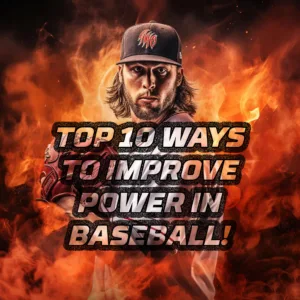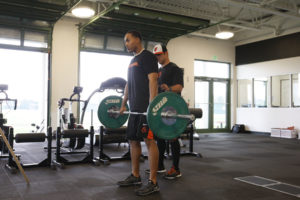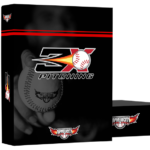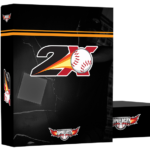 Tired of doing hundreds of reps with light tubing or dumbbells with little results? Bored of tweaking your mechanics to death to try and squeeze one more oz of power out of your body? Sick of buying worthless devices to help improve baseball power to quickly realize it was a total waste of your time and money? Well, stop chasing your tail. Baseball is infamous for under developing peak potential in this game. Don't get caught in its trap and spend the rest of your life living in regret, wondering if you ever could have been better.
Tired of doing hundreds of reps with light tubing or dumbbells with little results? Bored of tweaking your mechanics to death to try and squeeze one more oz of power out of your body? Sick of buying worthless devices to help improve baseball power to quickly realize it was a total waste of your time and money? Well, stop chasing your tail. Baseball is infamous for under developing peak potential in this game. Don't get caught in its trap and spend the rest of your life living in regret, wondering if you ever could have been better.
The ONLY way, and I mean the ONLY way, to gain elite power in baseball is defined in the top 10 list in this article. It doesn't matter if you are a position player working on bat power or a pitcher working on pitching velocity, power is the source of peak performance and most baseball players do not have enough of it. Why would Performance Enhancing Drugs (PED's) be such a problem in this game if this statement wasn't true? Why would a million dollar business around performance enhancing devices for baseball exist if this claim wasn't true? Why would you be reading this article if you didn't agree that elite power is a true commodity of the game of baseball today? So let's assume we are on the same page here and NOT follow in the footsteps of baseball and continue to beat around the bush when it comes to developing yourself into the most powerful baseball player your body can produce.
In this article, I will not just give you the top ten ways to develop elite power in baseball but I will give you the most common ways to waste your time trying to develop it. I will also list some studies proving the effects of this approach to counter all of the miss information in the game today. Last of all I will go over how the 2X and 3X Velocity Programs work to implement this elite power training approach so you can live your dreams in this awesome game.
The Science of Elite Power in Baseball
So where does power come from in the game of baseball? It comes from the big muscle groups like the legs, core, chest and back. Science has discovered a strong correlation to overall physical fitness in these big muscle groups to baseball performance.
The results from a partial correlation analysis indicated a significant correlation between the following: batting evaluation with back strength (p , 0.01) and medicine ball throwing (p ,0.01); fielding evaluation with throwing distance (p , 0.05); and running evaluation with medicine ball throwing (p , 0.01), standing long jump (p , 0.05), T-test (p , 0.01), and base running (p , 0.01). It is certain that the performance of college baseball players is related to their physical fitness (4).
There is one large muscle group in particular though that holds a stronger correlation to baseball performance than the rest and that is leg power. Leg power has been shown to have a positive relationship with throwing velocity, bat speed, and batted-ball velocity (5,6,7,19,22,24). If the leg power is so important to producing the power of the game then how do we develop more of it?
To answer this question we need to look at the best way to measure leg power, so science can lead us to the most effective way to increasing leg power. A simple way of measuring leg power has been the vertical jump test (17). If someone can jump far off the ground then is this a good indication that they have a lot of leg power? Let's look at a study of the anthropometrics and performance data of professional baseball to see if vertical jump has a strong correlation to separating the levels of the game:
No differences were noted in vertical jump height between the players at any of the levels of professional baseball. However, significant differences were observed in vertical jump power. Players in MLB had significantly greater peak and mean jump power than players in the AA, A, and Rookie leagues. In addition, players in the AAA and AA leagues had significantly greater peak and mean jump power than players in the A and Rookie league (3).
This study is telling us that vertical jump height may NOT be a good indication of leg power alone but the power produced in the vertical jump is the best measurement of leg power. So what is the difference between vertical jump height and vertical jump power? Vertical jump power is when body weight is added to the equation. For example, if I can jump 30 inches at 215lbs and you can jump 30 inches at 165lbs then who is pushing out more power? The answer would be me of course!
Not only is body mass a key part of accessing leg power but studies show that it stands up pretty well on its own when it comes to better performance.
Findings from this study suggest the importance of addressing body composition within baseball training goals, since a more favorable body composition (higher %LBM, lower %BF) was associated with better performances on several tests commonly used to assess performance potential in collegiate baseball players (2).
This gives me the understanding that leg power and body mass are very close related in the power game of baseball. Now that we know to increase leg power it not only takes improving vertical jump height but body mass at the same time, so lets now look at if it is possible to improve vertical jump height with body mass and how is it done best.
Well, of course we can increase vertical jump height, body mass and overall leg power. We have countless studies proving this with some of them listed in this article but before we dive into the most effective way to develop this elite leg power let's first look at the least effective ways which most of baseball wastes their time doing.
How to Waste Your Time Training for Power in Baseball
 If your answer to the picture at the top of the article was #1 Baseball Power Tubing then you have more than likely wasted a ton of time trying to develop elite power with the list below in this game of baseball.
If your answer to the picture at the top of the article was #1 Baseball Power Tubing then you have more than likely wasted a ton of time trying to develop elite power with the list below in this game of baseball.
List of training exercises that have no correlations to negative correlations to developing peak power:
- Light resistance tubing exercises
- High rep weight training
- General strength training protocol
- Machine weight training
- Rotational training devices
- Wips and chain exercises
- Long distance throwing
- Mechanical adjustment drills
- This device here -->
It is not that all the items listed above are bad for baseball, it is that all of them are ineffective in developing elite power. Now for the list that is going to not only help you develop elite power in baseball but is going to change your game forever.
Top Ten Ways to Develop More Power in Baseball
 There are many coaches and players out there who believe and even promote that any strength, speed or power training does not enhance performance on the baseball field. If you believe this nonsense then you really need to read the endless number of studies that prove otherwise. Here is an example of one of them:
There are many coaches and players out there who believe and even promote that any strength, speed or power training does not enhance performance on the baseball field. If you believe this nonsense then you really need to read the endless number of studies that prove otherwise. Here is an example of one of them:
It is concluded that ballistic resistance training can increase performance in baseball throwing and base running, thus such training methods should be incorporated in baseball training programs (1).
The question now still remains how do we increase leg power to the elite level. The majority of coaches in this game would find this answer to be way out of left field or totally ridiculous to the sport of baseball like it has no place in this game but the best answer is Olympic Lifting. Yes, I said Olympic Lifting, hear me out before you freak out and close this page.
You will actually find this answer to be more popular than you thought when you look at the amount of Major League Baseball coaches who indicated that their athletes use this form of power training. Five of 21 coaches (23.8%) indicated that their athletes use Olympic-style lifts in a 2005 study (18). The Baltimore, Orioles have even built an Olympic strength and conditioning facility in their spring training complex. You can learn more in my article MLB Promotes Olympic Lifting for All Baseball Players.
So why are these organizations using these lifts and why are the most power athletes in the world using these lifts to develop elite power? Here are several different case studies defining the effectiveness of Olympic training for developing elite power that you need to learn by heart.
Olympic-style lifts and their derivatives (e.g., power clean, snatch) are also considered the best training exercises to maximize muscular power and dynamic athletic performance because they are multijoint exercises, they do not have the problem of deceleration phase, and they produce some of the highest average human power outputs of all the resistance-training exercises (14).
Because of the potential of these lifts to produce high-power outputs and their movement- and velocity- specificities to many sport activities (e.g., jumping, running, throwing), Olympic-style lifts are considered as some of the best training exercises to maximize dynamic athletic performance (14).
Significant improvements were seen in 1RM squat in both the OL and PL groups. After log10-transformation, OL were observed to have a significantly greater improvement in AVJ than PL. Despite an 18% greater improvement in 1RM squat (p > 0.05), and a twofold greater improvement (p > 0.05) in 40-yard sprint time by OL, no further significant group differences were seen. Results suggest that OL can provide a significant advantage over PL in vertical jump performance changes (8).
Olympic lifting proven most effective training in enhancing vertical jump height and power (8,9).
Studies show Olympic Lifting is most effective form of training to remodel or hypertrophy fast twitch muscle fiber (10,11).
The last citation says it all. The most effective form of training to remode; or hypertrophy fast twitch muscle fiber. This means it is an alternative to PED's because all that PED's do for an athlete is remodel or hyptrophy fast twitch muscle fiber.
So, do any of the other popular lifts in the weight room as effective as the Olympic lifts? Well ,just look at the power wattage measured from all the lifts with a 100kg male and a 75kg female and you will have your answer:
- Bench Press 300 Watts
- Back Squat 1100 Watts
- Deadlift 1100 Watts
- Snatch* 3000 1750 Watts
- 2nd Pull** 5500 2900 Watts
- Clean 2950 1750 Watts
- 2nd Pull 5500 2650 Watts
- Jerk 5400 2600 Watts
- Exercise Absolute Power (Watts)
100kg Male 75kg Female
*Total pull: Lift-off until maximal vertical velocity
**2nd pull: Transition until maximal vertical barbell velocity
Once you start to learn that your coaches and instructors in this game have been holding the secret to elite power in baseball from you then you start to wonder if there is a catch. Well there is but the risk concern isn't one of them. Is Olympic lifting dangerous? This is a major concern when it comes to this style of lifting mainly because people in this country have no form of basic education when it comes to Olympic lifting, so instead of doing like everyone else and living in ignorance, checkout my article called, Baseball More Dangerous Than Olympic Lifting, to learn the facts behind the dangers of Olympic lifting.
So, if the injury concern isn't the catch then what is it? The catch is the challenge of learning these highly technical lifts and developing the technique to perform them so you are not at risk of injury and you have the full potential to maximum power. Unfortunately, you will never maximize your power if you can not perform these lifts at a high level. Mainly because without proper technique you will not be able to train with enough resistance. Here is several case studies defining the importance of the heavy load and the 80% threshold to maximizing power:
The inclusion or not of body mass to determine the load that maximizes mechanical power output affects the long-term adaptations differently in the load-power relationship. Thus, training load selection will depend on the required adaptations. However, the use of heavy loads causes greater overall neuromuscular adaptations in moderately trained individuals (13).
Garhammer suggested 80% of 1RM maximized mechanical power output in Olympic-style lifts.... Although Haff et al. investigated power output during midthigh pull at 80%, 90%, and 100% of 1RM and found a general trend of increasing power output as the load was decreased from 100 to 80%, they failed to use lighter loads (<80% of 1RM) and did not find the peak of the power-load curve (14).
Now that you have a complete understanding of what it takes to develop elite power in baseball here is the specific ways to go about it.
Top 10 Ways to Develop Elite Power in Baseball
- Heavy Load Training
- High Speed Light Load Training
- Squat Variations
- Dead Lift Variations
- Clean Variations
- Jerk Variations
- Snatch Variations
- Periodization
- 80% Thresholds
- Dynamic Variable Resistance
This top 10 list and the info leading up to it mainly focuses on the lower half. The only part of the body left to build power in after the legs and core is the upper body like the chest and back. We can also increase our power output in baseball with the upper half.
These muscles, the pectoralis major, serratus anterior, sub scapularis, and latissimus dorsi, had stronger activity during the propulsive phase of the pitch (16)
There are two large muscle groups in the upper body that generate power and that is the pecs and lats as defined in the case study above. Strudies have correlated the strength/power development of these muscles to baseball performance.
The data indicate that training with chain- and plate-loaded resistance produce similar short-term strength improvement on the chain- and plate-loaded bench press. Baseball players may benefit from CBP training with improved free-weight strength while minimizing shoulder stress (15)
The last way to develop elite power from the top 10 list was Dynamic Variable Resistance. What id dynamic variable resistance?
Variable resistance training with elastic bands appears to provide greater performance benefits with regard to peak force and peak power than heavy, slow resistance exercise. Sports conditioning professionals can utilize bands, and high-speed contractions, to increase power development (12).
We can also train with Dynamic Variable Resistance using chains or other ways to increase the loads with the increase in the range of motion in the lift which have been linked to increasing power development.
Let's recap!
Don't waste your time anymore with baseball training that doesn't correlate to maximizing power. Take the time to learn the technique around the Olympic lifts so you can work up to the 80% threshold to maximize power. Use Dynamic Variable Resistance to to help break through plateaus in your power development. Now for the last piece of the puzzle you will need to use a periodization model with your training to reach your full power potential. In this next section I will define the periodization model and recommend the programs that use it.
The Power of the 2X & 3X Velocity Programs
 First what is periodization?
First what is periodization?
Periodization is the systematic planning of athletic or physical training.[1] The aim is to reach the best possible performance in the most important competition of the year.[2] It involves progressive cycling of various aspects of a training program during a specific period. Conditioning programs can use periodization to break up the training program into the offseason, preseason, in-season, and the postseason. Periodization divides the year round condition program into phases of training which focus on different goals. http://en.wikipedia.org/wiki/Sports_periodization
This is not only a standard of program development in all of sports but also Major League Baseball:
Eighteen of 21 (85.7%) of MLB S&C coaches follow a periodization model (18).
Both the 2X Velocity and 3X Velocity Programs are Olympic-style strength/power and conditioning programs built on a full periodization model that uses 8 week cycles from the off-season into pre and in-season training where the cycles rotate around either a relief or starter rotation.
 To learn more about these revolutionary performance enhancement programs for baseball and step into the most effective training to enhance power in the game of baseball checkout the links below and get started today:
To learn more about these revolutionary performance enhancement programs for baseball and step into the most effective training to enhance power in the game of baseball checkout the links below and get started today:
3X Pitching Velocity Program
This program was developed for the pitcher.
2X Velocity Program
This program was developed for the position player.
Reference:
- Kerry P. McEvoy, Robert U. Newton - Baseball throwing speed and base running speed: the effects of ballistic resistance training - Journal of strength and conditioning research 01/1998; 12:216-221.
- Muth, B., Witmer, CA., Davis, SE., Guers, J. - The Relationship Between Body Composition and Baseball Performance in Division II Baseball Players - East Stroudsburg University, East Stroudsburg, PA.
- Hoffman JR1, Vazquez J, Pichardo N, Tenenbaum G. - Anthropometric and performance comparisons in professional baseball players. - J Strength Cond Res. 2009 Nov;23(8):2173-8.
- Kohumura, Y, Aoki, K, Yoshigi, H, Sakuraba, K, and Yanagiya, T. - Development of a baseball-specific battery of tests and a testing protocol for college baseball players. - J Strength Cond Res 22: 1051– 1058, 2008.
- Bonnette R, Spaniol F, Melrose D, Ocker L, Paluseo J, and Szymanski D. - The relationship between rotational power, bat speed, and batted-ball velocity of NCAA Division I baseball players. - J Strength Cond Res 22(6): e112, 2008.
- Reed JG, Szymanski DJ, Albert JM, Hawthorne LZ, Hemperley DL, Hsu HS, Skinner CJ, and Tatum JR. - Relationship between physiological performance variables and baseball/softball specific variables of novice college students. - J Strength Cond Res 21(4): 111–112, 2008.
- Spaniol FJ. - Physiological predictors of bat speed and throwing velocity in adolescent baseball players. - J Strength Cond Res 16(4): 6, 2002.
- Hoffman JR, Cooper J, Wendell M, Kang J. - Comparison of Olympic vs. traditional power lifting training programs in football players. - Department of Health and Exercise Science, The College of New Jersey, Ewing, New Jersey 08628-0718, USA. - J Strength Cond Res. 2004 Feb;18(1):129-35.
- Channell BT, Barfield JP. - Effect of Olympic and traditional resistance training on vertical jump improvement in high school boys. - Oliver Springs High School, Oliver Springs, Tennessee, USA. - J Strength Cond Res. 2008 Sep;22(5):1522-7.
- Fry AC, Schilling BK, Staron RS, Hagerman FC, Hikida RS, Thrush JT. - Muscle fiber characteristics and performance correlates of male Olympic-style weightlifters. - Human Performance Laboratories, The University of Memphis, Tennessee 38152, USA. - J Strength Cond Res. 2003 Nov;17(4):746-54.
- Tesch PA, Thorsson A, Essén-Gustavsson B. - Enzyme activities of FT and ST muscle fibers in heavy-resistance trained athletes. - J Appl Physiol. 1989 Jul;67(1):83-7.
- Rhea MR1, Kenn JG, Dermody BM. - Alterations in speed of squat movement and the use of accommodated resistance among college athletes training for power. - J Strength Cond Res. 2009 Dec;23(9):2645-50.
- Smilios I1, Sotiropoulos K, Christou M, Douda H, Spaias A, Tokmakidis SP. - Maximum power training load determination and its effects on load-power relationship, maximum strength, and vertical jump performance. - J Strength Cond Res. 2013 May;27(5):1223-33.
- Kawamori N, Haff GG. - The optimal training load for the development of muscular power. - Department of Kinesiology, Midwestern State University, Wichita Falls, Texas 76308, USA. - J Strength Cond Res. 2004 Aug;18(3):675-84.
- McCurdy K1, Langford G, Ernest J, Jenkerson D, Doscher M. - Comparison of chain- and plate-loaded bench press training on strength, joint pain, and muscle soreness in Division II baseball players. - J Strength Cond Res. 2009 Jan;23(1):187-95.
- Gowan ID1, Jobe FW, Tibone JE, Perry J, Moynes DR. - A comparative electromyographic analysis of the shoulder during pitching. Professional versus amateur pitchers. - Am J Sports Med. 1987 Nov-Dec;15(6):586-90.
- Carmelo Bosco, Pekka Luhtanen, Paavo V. Komi - A simple method for measurement of mechanical power in jumping - European Journal of Applied Physiology and Occupational Physiology. January 1983, Volume 50, Issue 2, pp 273-282.
- Ebben WP1, Hintz MJ, Simenz CJ. - Strength and conditioning practices of Major League Baseball strength and conditioning coaches. - J Strength Cond Res. 2005 Aug;19(3):538-46.




I completely agree with you that strength training enhances athletic performance. I have been training my players for about one year now and each one of them has mentioned to me at one time or another that the secret to their HUGE improvement on the mound and in the batter’s box was indeed the weightlifting. Whoever says it doesn’t work is old school and simply needs to get with the times. The truth is science has caught up with the game!